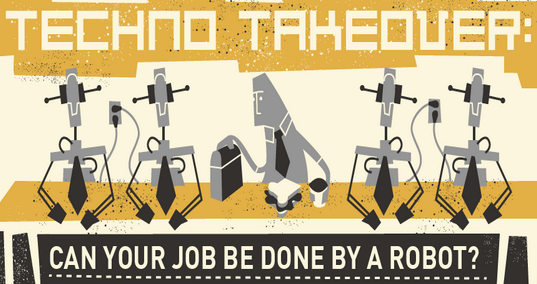aNewDomain.net — All the repetitive jobs are going out the window. Big data-related work is endangered, too. Check out the techno takeover infographic, below. The first jobs to go, researchers say, are already on their way out. Those include the jobs of retail clerks, cashiers, paralegals, armed forces, medical transcriptionists, commercial drivers and customer service representatives.

As Derek Thompson in The Atlantic writes: “Machines are better at rules and routines,people are better at directing and diagnosing.” There’s still time to become a doctor. Really . Any H2H job will also have its advantages. Human to Human versus B2B or B2C….
Infographic credit: mindflash
For aNewDomain.net, I’m David Michaelis.
Based in Australia, David Michaelis is a world-renowned international journalist and founder of Link Tv. At aNewDomain.net, he covers the global beat, focusing on politics and other international topics of note for our readers in a variety of forums. Email him at DavidMc@aNewDomain.net.














Robot customer service attendants are already here. They sound like they’re a person holding a conversation with you, and they screen your call so that they can route it to the right person. (Not to mention the “traditional” automated phone attendants — “Press 1 for a company directory…” — have probably eliminated a lot of jobs already.
The only thing positive about this automation is it takes LOTS of people to keep things running smoothly, I work in a manufacturing plant that has “automated” one product line – problem is it doesnt work as designed and they had to hire 3 shifts of people to hand carry parts around to feed the “automated” line along with a team of techs to keep it running which they arent very good at doing!
[…] Robert Cole YouTube Channel As it happens, I, too, reviewed the original Apple Macintosh when it came out in 1984. I’ve […]
Put down meteorologists in the coming 10 to 15 years, at least for the forecasting. The computing power to run high resolution models in an ensemble approach (multiple runs of the models varying starting conditions and physics packages) so that there is a statistically meaningful set to do probabilistic forecasting. After that it will take a dense network of radars with computing power to do the warnings. That will probably be 10 years after we get pulled from forecasting.
[…] aNewDomain.net — The future may hold a slew of robots that can accomplish a human’s daily tasks with ease and precision. I’ve already discussed the seven jobs that are evaporating as we speak. […]
[…] – Earlier this week, I wrote about seven jobs that are going away fast. Bots are taking them over. I followed that up with an essay about how artificially intelligent machines will never […]